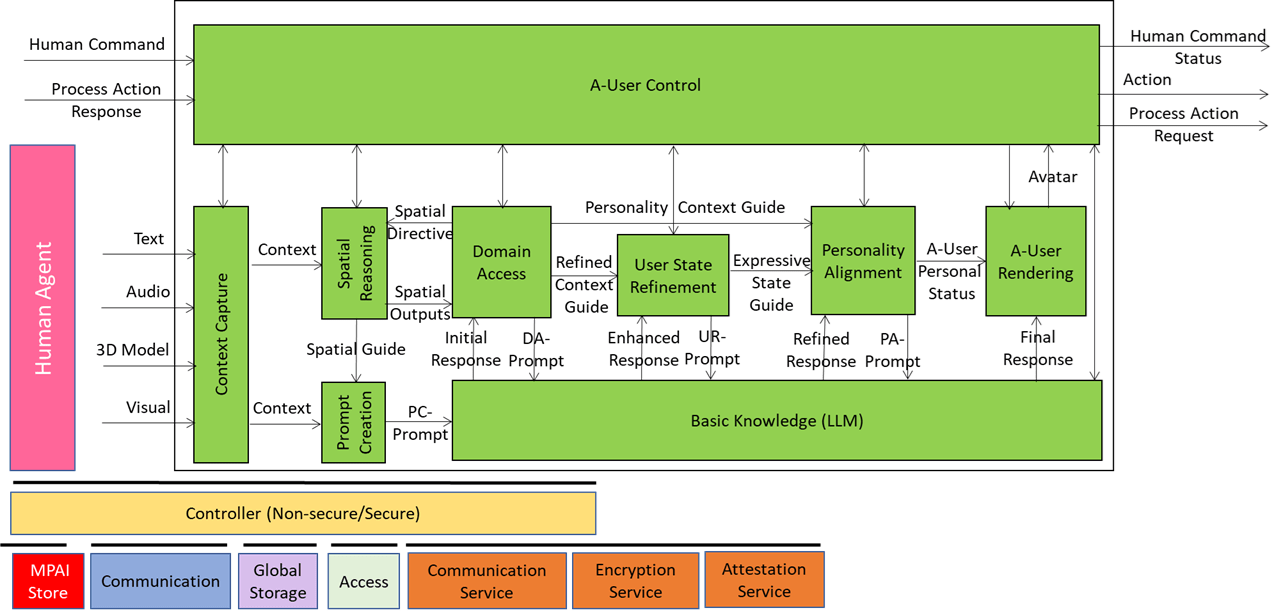Basic Knowledge is the core language model of the Autonomous User – the “knows-a-bit-of-everything” brain. It’s the first responder to a prompt but it doesn’t fire off just one answer but four of them in a progressive refinement loop, providing smarter and more context-aware responses with every refined prompt.
We have already presented the system diagram of the Autonomous User (A-User), an autonomous agent able to move and interact (walk, converse, do things, etc.) with another User in a metaverse. The latter User may be an A-User or be under the direct control of a human and is thus called a Human-User (H-User). The A-User acts as a “conversation partner in a metaverse interaction” with the User.

This is the seventh of a sequence of posts aiming at illustrating more in depth the architecture of an A-User and provide an easy entry point for those who wish to respond to the MPAI Call for Technology on Autonomous User Architecture. The first six dealt with 1) the Control performed by the A-User Control AI Module on the other components of the A-User; 2) how the A-User captures the external metaverse environment using the Context Capture AI Module; 3) listens, localises, and interprets sound not just as data, but as data having a spatially anchored meaning; 4) makes sense of what the Autonomous User sees by understanding objects’ geometry, relationships, and salience; 5) takes raw sensory input and the User State and turns them into a well‑formed prompt that Basic Knowledge can actually understand and respond to; and 6) taps into domain-specific intelligence for deeper understanding of user utterances and operational context.
Basic Knowledge is the core language model of the Autonomous User – the “knows-a-bit-of-everything” brain. It’s the first responder to a prompt but it doesn’t fire off just one answer but four of them in a progressive refinement loop, providing smarter and more context-aware responses with every refined prompt.

The Journey of a Prompt
- Starts Simple: The first prompt from Prompt Creation is a rough draft because the A-User has only a superficial knowledge of the Context and User intent.
- Domain Access adds expert seasoning: jargon, compliance rules, reasoning patterns. The prompt becomes richer and sharper.
- User State Refinement injects dynamic knowledge about the User – refined emotions, more focused goals, better spatial context – so the prompt feels more attuned to what the User feels and wants.
- Personality Alignment Tells A-User how to Behave: it ensures that the appropriate A-User’s style and mood drive the next prompt.
- Final Prompt Delivery: when Basic Knowledge receives the last prompt (from Personality Alignment) the final touches have been added.
This sequence of prompts eventually provides:
- Better responses: Each prompt reduces ambiguity.
- Domain grounding: Avoids hallucinations by embedding rules and expert logic.
- Personalisation: Adapts A-User’s tone and content to User State.
- Scalability: Works across domains without retraining.
Basic Knowledge starts as a generalist, but thanks to refined prompts, it ends up delivering expert-level, context-sensitive responses. It starts from a rough sketch and, by iterating with specialist information sources, it provides a response that includes all the information extracted or produced in the workflow.
Key points to take away about Basic Knowledge
- Is the core language model of the A-User – generalist brain.
- Works in four progressive refinement steps.
- Starts with Prompt Creation prompt, a rough draft with limited context.
- Domain Access adds jargon, compliance rules, reasoning patterns.
- User State Refinement injects emotions, focused goals, spatial context.
- Personality Alignment ensures style and mood match User State.
- Each refinement step reduces ambiguity and improves accuracy.
- Benefits: better responses, domain grounding, personalisation, scalability.
- Basic Knowledge starts as a generalist but ends up delivering an expert-level, User-sensitive, and A-User aware response.



